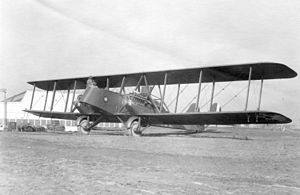Martin MB-2
| Martin NBS-1 | |
|---|---|
 |
|
| Role | Short-range night bomber |
| Manufacturer | Glenn L. Martin Company |
| First flight | 3 September 1920 |
| Introduction | 1920 |
| Retired | 1929 |
| Status | No known survivors |
| Primary user | United States Army Air Service |
| Produced | 1920-1922 |
| Number built | 130 |
| Unit cost |
US$23,485 (1920)
|
The Martin NBS-1 was a military aircraft of the United States Army Air Service and its successor, the Air Corps. An improved version of the Martin MB-1, a scout-bomber built during the final months of World War I, the NBS-1 was ordered under the designation MB-2 and is often referred to as such. The designation NBS-1, standing for "Night Bomber-Short Range", was adopted by the Air Service after the first five of the Martin bombers were delivered.
The NBS-1 became the standard frontline bomber of the Air Service in 1920 and remained so until its replacement in 1928-1929 by the Keystone Aircraft series of bombers. The basic MB-2 design was also the standard against which prospective U.S. Army bombers were judged until the production of the Martin B-10 in 1933.
The NBS-1 was a wood-and-fabric biplane without staggered wings, employing twin rudders on a twin vertical tail. Its two Liberty 12-A engines sat in nacelles on the lower wing, flanking the fuselage. Ordered under the company designation MB-2 in June 1920, the NBS-1 was an improved larger version of the Martin MB-1 bomber built by the Glenn L. Martin Company in 1918, also known as the GMB or Glenn Martin Bomber. The first flight of the MB-2 took place 3 September 1920.
In addition to more powerful engines, larger wings and fuselage, and simplified landing gear, the NBS-1 also had a unique folding wing system, hinged outside the engine nacelles to fold backwards for storage in small hangars. Unlike the MB-1, whose engines were mounted between the wings in a fashion similar to the German Staaken R.VI Riesenflugzeug, the engines of the NBS-1 were fixed to the lower wing over the landing gear.
The MB-2 was designed as a night bomber and except for a greater load capacity, had reduced performance characteristics compared to its MB-1 predecessor. The first 20 (five MB-2s and 15 NBS-1s) were ordered from the Martin Company, which recommended a further 50 be produced to help its struggling financial condition. However the design was owned by the U.S. Army and subsequent contracts for 110 bombers were awarded by low bid to three other companies: Lowe Willard and Fowler Engineering Company of College Point, New York (35 ordered), Curtiss Aircraft (50), and Aeromarine Plane and Motor Company of Keyport, New Jersey (25).
...
Wikipedia
